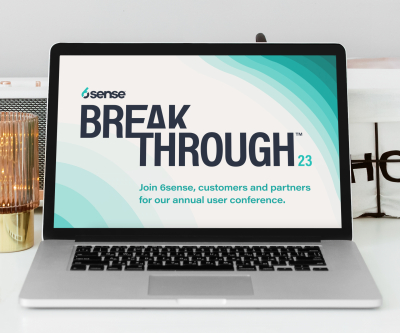6sense CEO Discusses Strategic Acquisition & Its Role In The ‘RevTech Revolution’
- Written by Kelly Lindenau
- Published in Blog
 Enhancement has been the name of the Q3 game for 6sense and its account engagement platform. The company started off by expanding its partnership with Bombora to improve its predictive analytics engine, and now it’s closing out by acquiring Fortella, an AI-based revenue intelligence platform.
Enhancement has been the name of the Q3 game for 6sense and its account engagement platform. The company started off by expanding its partnership with Bombora to improve its predictive analytics engine, and now it’s closing out by acquiring Fortella, an AI-based revenue intelligence platform.
The acquisition seeks to provide 6sense users with essential pipeline planning, forecasting and measurement capabilities to achieve their pipeline and revenue goals with greater predictability. To find out how the merger will help build upon 6sense’s existing capabilities, Demand Gen Report sat down with Jason Zintak, CEO of 6sense, to learn about the company’s journey to becoming a complete revenue technology (RevTech) platform.
Demand Gen Report: Why did you decide to acquire Fortella? What aspects of its platform made it so appealing?
Jason Zintak: At 6sense, we’re on a mission to fundamentally shift the way revenue teams go to market and achieve success. And we believe that technology — data, insights and AI-driven predictions — is key to keeping the whole team aligned on their most important metric: Revenue.
While our customers have seen incredible success using our technology to take the guesswork and legwork out of much of the process, they were still relying on manual approaches to planning and forecasting pipeline. We saw an opportunity to get them to the next level by teaming up with Fortella. As the only AI-driven pipeline intelligence platform on the market, Fortella is the perfect solution for extending the value of 6sense and creating a truly end-to-end platform for B2B teams to predictably achieve revenue growth.
DGR: Why did you decide to initiate the acquisition? Did it align with any internal goals?
Zintak: When we took on funding earlier this year, we made a promise to change the future of the B2B buying and selling experience. It’s a future that we’re strategically designing, and we call it the “RevTech Revolution.” Part of our strategy for creating and accelerating the changes we envision is to align with the very best partners we can, and Fortella certainly fits that bill.
No one else is using AI to take the guesswork out of pipeline planning, forecasting and measurement. We know our customers are hungry for these capabilities right now, so we’re thrilled to be able to offer this immense value — and deliver on our RevTech Revolution promise — with the acquisition of Fortella.
DGR: How does the addition of Fortella’s offerings complement and enhance 6sense’s existing capabilities?
Zintak: We talk a lot about the revenue operating model — the method of working to achieve revenue goals by first establishing those goals and then working backward to set the steps in motion to achieve them. But until now, that process has been largely manual and built on assumptions plugged into spreadsheets. Ask any CMO or CRO out there, and they’ll tell you that they have massive spreadsheets for pipeline predictions — and I bet they’ll also tell you that they get heart palpitations when it comes time to defend them to the board or the rest of the executive team.
Fortella takes all the assumptions, hunches and sweaty palms out of the pipeline prediction piece. With 6sense and Fortella, revenue teams can now create precise, detailed pipeline-production goals. They can also uncover, prioritize and engage buyers to meet those goals, and then forecast and measure progress against those goals, making real-time adjustments as needed.
DGR: How will the enhancements provided by Fortella’s AI-driven technology benefit 6sense customers?
Zintak: Together, 6sense and Fortella will provide benefits that are felt throughout our customers’ organizations — but perhaps nowhere more so than in the marketing and sales departments. Sales and marketing care equally about pipeline planning and forecasting, but until now, it’s been difficult for the teams to collaborate around mutual goals. It’s also been a challenge to draw direct lines from what the teams are doing to what revenue it creates.
Now, B2B marketers and sellers can take the uncertainty, assumptions and manual labor out of their planning. They’ll have an easy-to-navigate roadmap for reaching their No. 1 goal: Revenue. And if they’re off course at any point, they’ll get actionable insights that point them to exactly how to get back on track.
That’s going to be key to elevating the conversations marketers and sellers have at the highest levels within their companies, the C-suite and the board. Because in those conversations, no one cares what activities you’re working on or how many leads you’ve qualified. They want to know how much pipeline you’re expecting to generate next quarter, and the quarter after that, and the quarter after that. And they want to know whether you’re on track to achieve it.
DGR: How does the acquisition lay the groundwork for future product innovation and other acquisitions?
Zintak: When we made our RevTech Revolution promise, we committed to accelerating our already aggressive product roadmap. We knew that would entail expanding our robust data layer, continuing to lead the market in terms of prediction capabilities and building our AI-based orchestration functionality.
By acquiring Fortella, we’re seamlessly integrating two crucial AI-powered capabilities — planning and forecasting. And that means our team is freed up to focus on the next innovations that will help us continue to enable B2B businesses to deliver ideal customer journeys at scale, based on real-time data and insights.
Related items
-
 6sense Research: 84% Of B2B Deals Are Decided Before Marketers Even Know About Them
6sense Research: 84% Of B2B Deals Are Decided Before Marketers Even Know About Them
-
 6sense Breakthrough Recap: B2B Orgs Increase Pipeline To Revenue Creation By Prioritizing Automation, Communication & Alignment
6sense Breakthrough Recap: B2B Orgs Increase Pipeline To Revenue Creation By Prioritizing Automation, Communication & Alignment
-
 6sense Names Latané Conant As Chief Revenue Officer
6sense Names Latané Conant As Chief Revenue Officer
-
 6sense Breakthrough Preview: CRO Latané Conant On How The Event Will Help Marketers ‘Be More’
6sense Breakthrough Preview: CRO Latané Conant On How The Event Will Help Marketers ‘Be More’
-
 6sense To Host 5th Annual ‘Breakthrough’ Event
6sense To Host 5th Annual ‘Breakthrough’ Event



